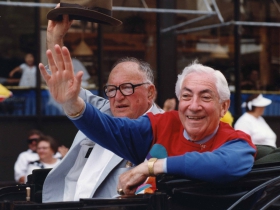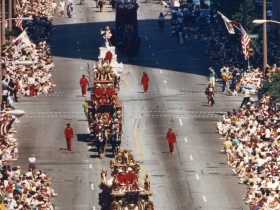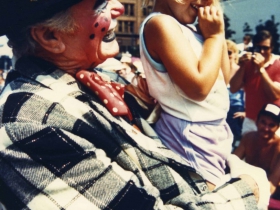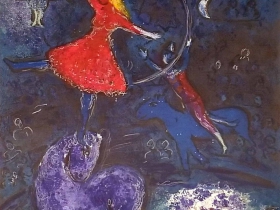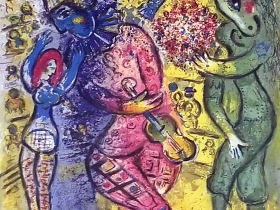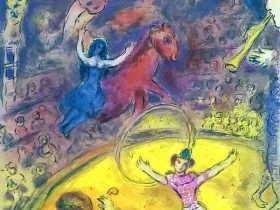The Circus Is In Town
Jewish Museum presents the often surreal images of the circus by beloved artist Marc Chagall.
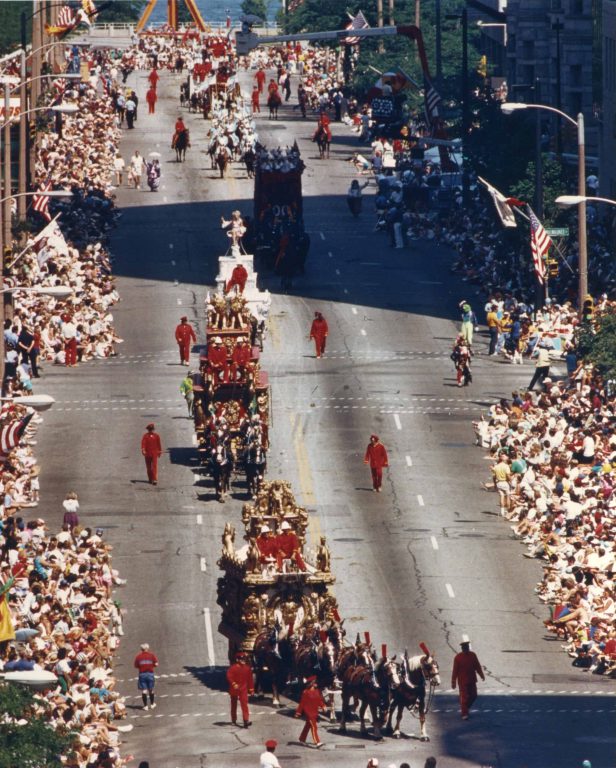
The Circus Parade on Wisconsin Ave., late 1990s. Image courtesy of Jewish Museum Milwaukee, Barkin Family Collection
Jewish Museum Milwaukee’s current exhibit pays tribute to a leading artist in the early modernist and Cubism movementa, as well as to Wisconsin’s long history with the circus.
Artist Marc Chagall’s “Le Cirque,” a collection of more than three dozen of Chagall’s black-and-white and color lithographs–published by Teriade Editions in 1967 and on loan from Manitowoc’s Rahr-West Art Museum–will be on display at the museum through September 8. The exhibit kicked off June 13, with an opening reception that featured a talk by Chagall’s granddaughter, Bella Meyer.
Featuring dreamlike, intensely-colored portrayals of acrobats, clowns, horses, dancers and musicians, “Le Cirque” captures the often-surreal atmosphere of the circus, a subject that fascinated Chagall since his childhood in Belarus (when it was still part of Russia). The circus performers in these lithographs appear to float through the air while crowds watch. The artist weaves worldly and otherworldly elements into his works, including fish, the moon, and animals with human bodies.
“For me, a circus is a magic show that appears and disappears like a world. These clowns, bareback riders and acrobats have made themselves at home in my visions,” wrote Chagall. The artist considered the circus the ultimate tragedy, and seems to have empathized with its performers, who would have been considered “freaks” by many at the time and were likely society outcasts and outsiders.
Born Moishe Segal, Chagall has been described as a Russian-French artist of Belarusian Jewish origin, though he ultimately lived in America. He moved to France in the 1920s. Two decades later, with the help of an American patron of the arts, he and his family managed to escape the country’s Nazi occupation by fleeing to the United States. Once lauded by the press, Chagall and other European Jewish artists sadly saw many of their works derided—and ultimately destroyed—by the Nazi Party. In 1937, a Munich exhibition entitled “Entarte Kunst” (“Degenerate Art”) declared pieces by modern artists like Chagall, Matisse and Picasso a threat to German sentiment and nationality.
“With time, the circus came to lie at the very heart of his personal mythology and became symbolic of the human condition,” the museum states in its notes on the exhibit.
To complement the Chagall exhibit, the Jewish Museum has displayed a number of Wisconsin circus artifacts, including costumes worn by performers, information about The Ringling Brothers Circus, which was founded in Baraboo, beautifully illustrated posters advertising Milwaukee’s The Great Circus Parade, a model of the 40-horse hitch (a cart pulled by dozens of horses) and a head sculpture of Great Circus Parade co-founder Ben Barkin. Although the Milwaukee circus parade has been discontinued, Baraboo continues to host a Big Top Parade and Circus Celebration. This year’s will be held on July 20.
The Jewish Museum Milwaukee, 1360 N. Prospect Ave., will host several events in conjunction with the Chagall exhibit, including Gallery Night July 19 and Gallery Day July 20; and Inspired Travel: Circus World Baraboo, 8 a.m. to 6 p.m. Wednesday July 24, a behind-the-scenes tour of Baraboo’s Circus World Museum. A pop-up gallery will be held 6 to 8:30 p.m. August 1 at the museum. For more information on upcoming events, visit the museum’s website.
Chagall Exhibit
If you think stories like this are important, become a member of Urban Milwaukee and help support real independent journalism. Plus you get some cool added benefits, all detailed here.
Art
-
Winning Artists Works on Display
 May 30th, 2024 by Annie Raab
May 30th, 2024 by Annie Raab
-
5 Huge Rainbow Arcs Coming To Downtown
 Apr 29th, 2024 by Jeramey Jannene
Apr 29th, 2024 by Jeramey Jannene
-
Exhibit Tells Story of Vietnam War Resistors in the Military
 Mar 29th, 2024 by Bill Christofferson
Mar 29th, 2024 by Bill Christofferson
Preview
-
PianoArts Festival Features Rising Stars
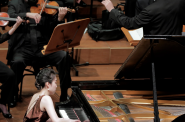 May 28th, 2024 by Michael Barndt
May 28th, 2024 by Michael Barndt
-
Four Nations Ensemble Goes For Baroque
 May 13th, 2024 by Michael Barndt
May 13th, 2024 by Michael Barndt
-
Mozart on Prospect Avenue
 May 9th, 2024 by Martha Brown
May 9th, 2024 by Martha Brown



